After working rather quickly through the last two units (1 – Bones and Fractures and 2 – Muscles and Sprains), in about 1 month each, this 3rd unit really stepped up the game for exciting and varied learning. It can really be broken down even farther into 4 separate sections; Wounds such as lacerations and punctures, Burns, Frostnip/bite, and Hypo/Hyperthermia. Partly as it has fallen over Christmas break and partly because it coincides with another rather lengthy unit we’re doing for Fire Fighter skills, we have taken quite a bit of time for this unit.
The basic goals of this unit:
- Learn about four basic types of wound: Laceration and Avulsion, Amputation, Shallow Wounds, and Puncture Wounds, and what makes a wound High Risk.
- Learn about treating each of these wounds by cleaning, dressing, and bandaging.
- Learn about the process of infection and how to prevent it and treat it, including systemic infection.
- Learn about the three degrees of burns.
- Learn the different methods for how to treat each kind of burn.
- Learn how to calculate the percentage of burns to a body.
- Learn the difference between Frostbite and Frost Nip
- Learn how to prevent and treat frostbite and frost nip, as well as trench foot.
- Learn about Hypothermia and Hyperthermia*
- Learn how to prevent and treat hypo and hyperthermia
- Learn about Fever and Heat Stroke related seizures.
- Continued practice with Triage
*Hypothermia and Heat Stroke can also be included with the Circulatory System Unit for convenience.
Our Reading Resources for Skin:
(Pictures of these books, more details about each, and some helpful links can be found on the Elementary First Responder Home Page.)
- The skin chapter of “The Human Body Book” by Parker
- The skin chapter of Reader Digest’s “How the Body Works;” pages 30-37
- The Skin and Soft Tissue Chapter in the Outward Bound book; pages 106-123
- The Cold Injury Chapter in the Outward Bound book; pages 154-158
- The Body Core Temperature Chapter in the Outward Bound book; pages 138-153
- The wounds an burns treatment section of your preferred 1st Aid book. (We have a Boy Scout 1st Aid handbook, and the John Hopkins First Aid for Children Fast book)
- SOAP study #22, #23, #6, #31, #25, #26, and #27 in the Wilderness Medicine Workbook
- Google types of wounds ***Warning: Graphic Images***
Some Hands-On Activities and Field Trip Ideas
- The Skin activity pages in Scholastic’s ‘The Body Book”
- Experiments on pages 35, 36, and 37 of Reader Digest’s “How the Body Works“
- The experiments in the Body Temperature section of Reader Digest’s “How the Body Works“
- Freeze a tomato and check out it’s skin, then again after it thaws, to learn about Frost Bite.
- Use make-up or washable markers to create wounds to dress and bandage on a victim
- OR Draw wounds on a cheap pair of painters cover-alls for a person or your skeleton cadaver to wear
- Play the ‘Sticker Game’ by hiding a small sticker somewhere on a ‘Victim’s’ clothing for the ‘EMT’ to find while when doing a full body scan. You can use your dummy or a live friend.
- Bandage your cadaver using the cravat and bandage ties from this Online PDF.
- Build your own 1st Aid kit
- Visit the drug store and explore all of the different dressing and bandaging product options
- Visit an EMT/Ambulance to specifically check-out their wound care equipment. Fire Engines have a lot of Life Support help, but these might be better after learning about the Respiratory System. You can also YouTube First Responders’ 1st Aid set-ups.
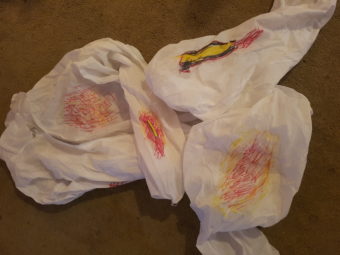
$3 Painter’s Cover-Alls with Fake Wounds
So how did it go for us?
As mentioned above, this unit has taken quite a bit of time. But I don’t think that’s a bad thing. After all, the most common issues any of us will ever come into contact with (not even as professionals) will certainly be items on the list above. Since I have been taking the time required to read through all of the pages for each of these topics in the Outward Bound book, that alone has meant a lot of reading sessions. Then we basically took 5 weeks off over Christmas!!! Although I used some of the CPT sessions for reading, there were a lot of days without.
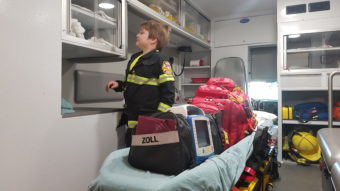 While we were on vacation we took the time to visit some fire stations. This was a great way for Nathan to see where ambulances and fire engines keep their wound care kits. He also got to help operate the electric gurney! (You can see that at the end of the video I attached at the bottom of this post.)
While we were on vacation we took the time to visit some fire stations. This was a great way for Nathan to see where ambulances and fire engines keep their wound care kits. He also got to help operate the electric gurney! (You can see that at the end of the video I attached at the bottom of this post.)
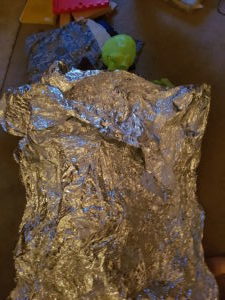 Finally we’ve finished up with some fun play practicing the rescue skills for wound care, hypothermia, and heat stroke. We put the skeleton into the colored cover-alls and treated his wounds. We also involved the daycare kids in some mock scenes. They really get a kick out of it. In addition to these activities we’re still adding to Nathan’s First Responder manual, as seen below with the printed off bandage pages. It now includes one page each for the types and treatment of the wounds and injuries we’ve just learned about, along with his own drawing about each.
Finally we’ve finished up with some fun play practicing the rescue skills for wound care, hypothermia, and heat stroke. We put the skeleton into the colored cover-alls and treated his wounds. We also involved the daycare kids in some mock scenes. They really get a kick out of it. In addition to these activities we’re still adding to Nathan’s First Responder manual, as seen below with the printed off bandage pages. It now includes one page each for the types and treatment of the wounds and injuries we’ve just learned about, along with his own drawing about each.
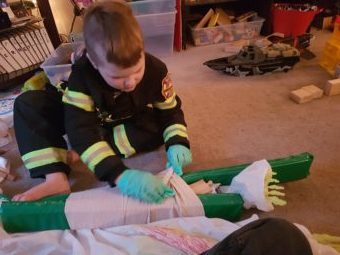
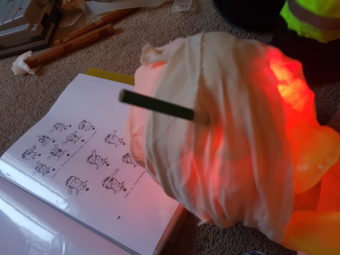
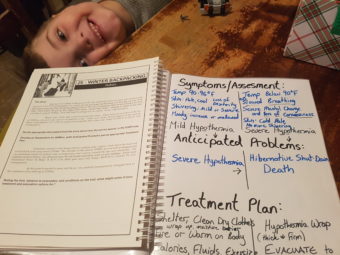
Here we are using Nathan’s personal First Responder Training Folder to decide what to do about a patient in the SOAP studies. I write out the cheat sheets for when he can read a little better and he adds drawings to show his understanding.
Needles to say, as you can see how much there was to this Unit as listed above. I am VERY excited to be starting a new year and a new unit – #4 – The Cardiovascular System. We’ll be sure to share all about it when we are finished!

Post a comment